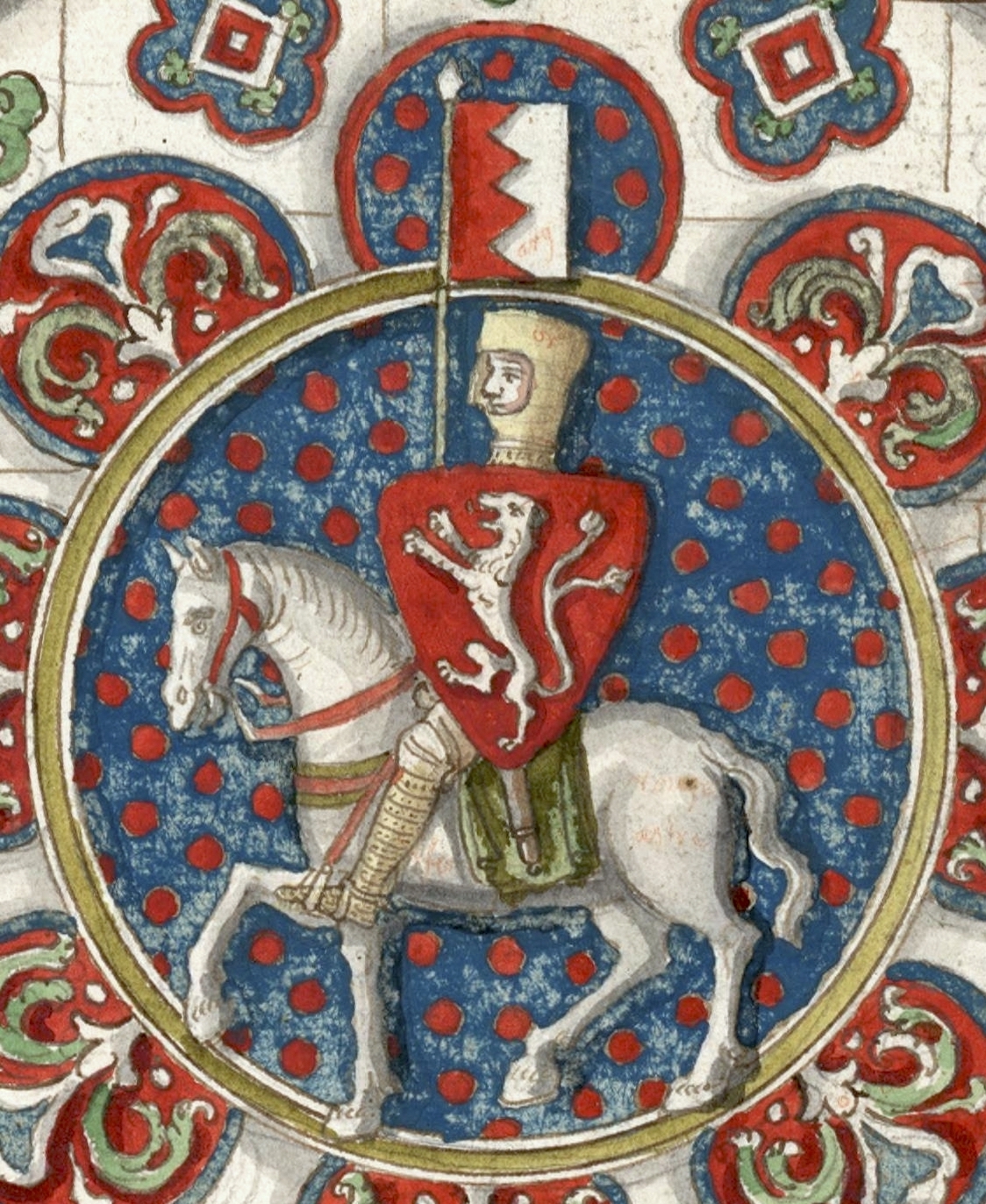 Above: Simon de Montfort, Chartes Cathedral.
Above: Simon de Montfort, Chartes Cathedral.
In January 1265 (the 20th, to be exact), England's first parliament in history met. The parliament was held until mid-March and was instigated by Simon de Montfort, who famously led the rebellion against King Henry III. Montfort is regarded today as one of the progenitors of modern parliamentary democracy by virtue of the fact that his parliament featured representatives of the shires and boroughs alongside the aristocracy and clergy. As Dominic Sandbrook notes, the 1265 parliament therefore 'posed a potent challenge to the king's monopoly of power'. Although Montfort cannot be termed a democrat in the modern sense of the word, he may potentially be seen 'as the accidental godfather of parliamentary democracy'.
Following his victory over the king at the Battle of Lewes during the Second Barons' War, Montfort realised that he needed support from a range of groups: not just the knights and nobility, but the town burgesses too. Although Montfort was killed at the Battle of Evesham later that year, his decision to invite burgesses to parliament, alongside knights, was taken on board by Edward I upon his succession. This had become normal by the fourteenth-century, and the gathering had become known as the House of Commons. Thus, Montfort is regarded as the founder of the Commons.
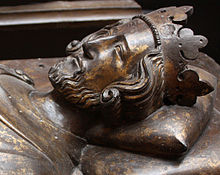 Above: Henry III, king of England from 1216 to 1272.
Above: Henry III, king of England from 1216 to 1272.
In the words of historian F.W. Maitland, the events of January 1265 transformed parliament 'from an occasion into an institution'. As Nicholas Vincent explains: 'Parliament's authority rested upon popular respect. Should it lose that respect, even today, then it forfeits all authority'. Because of Montfort's actions, parliament can celebrate 750 years of debate. Historians have viewed the January 1265 parliament as a populist and tactical move on Montfort's behalf in an attempt to garner further support with which to strengthen his position: thus Jeffrey Hamilton describes this parliament as 'a very partisan assembly, not some sort of proto-democratic representative body'. Anachronism, then, needs to be avoided in analysing the nature of the 1265 parliament. The parliament was primarily concerned with enforcing the Provisions of Westminster, including placing restrictions on the nobility and promising judicial assistance to those suffering the unfairness of feudal lordship.
In 1965, Parliament presented a loyal address to the British monarch, Elizabeth II, marking the 700th anniversary of Montfort's parliament. This year, Parliament planned a programme of events entitled "Parliament in the Making", including events to mark the 750th anniversary of the 1265 parliament. On 20 January 2015, "Democracy Day" was broadcast by the BBC to coincide with the 750th anniversary, consisting of live discussions and debate about the nature of parliamentary democracy. In all respects, then, the calling of the January 1265 parliament represented a turning point in English history. Parliament in thirteenth-century England was not the same as its twenty-first century equivalent, but Montfort's actions were unprecedented and helped to instil the principle of parliamentary democracy, which prevails to this day.
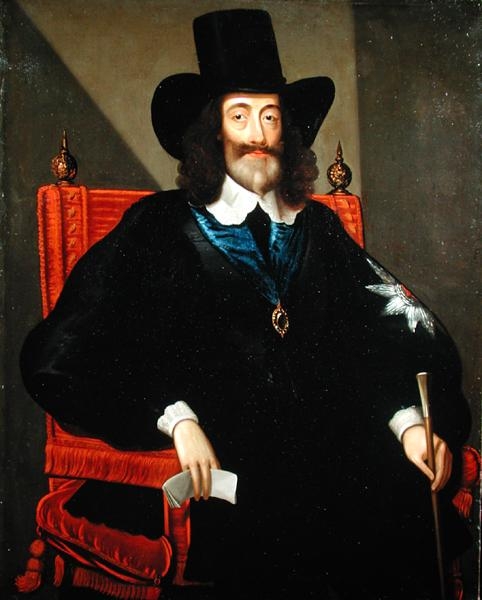 The execution of Charles I, king of England, Scotland and Ireland, on 30 January 1649 was unprecedented in its day. As historian Blair Worden explains, Charles' death 'left an indelible mark on the history of England and on the way that the English think about themselves', at what was the climatic moment of the Puritan Revolution. Occurring at a time when civil war had ruptured England's social, religious, and political life, Charles' beheading changed the subsequent nature of the conflict, and deepened the divisions.
The execution of Charles I, king of England, Scotland and Ireland, on 30 January 1649 was unprecedented in its day. As historian Blair Worden explains, Charles' death 'left an indelible mark on the history of England and on the way that the English think about themselves', at what was the climatic moment of the Puritan Revolution. Occurring at a time when civil war had ruptured England's social, religious, and political life, Charles' beheading changed the subsequent nature of the conflict, and deepened the divisions.
In the words of Sean Kelsey, Charles I's downfall 'stands out as probably one of the most remarkable, certainly one of the most dramatic events in the early modern history of the British Isles'. On 20 January, ten days before his death, the king was brought to Westminster Hall to hear the charges brought against him by his enemies. John Bradshaw acted as President of the Court, while the prosecution was led by John Cook, the Solicitor General. He was accused of governing by will and not by law (thus making him a tyrant) and had 'traitorously' levied war 'against the present parliament and the people there represented'.
Historians have argued that the trial saw Charles' 'finest hour', castigating his accusers fearlessly and boldly: "I do stand more for the liberty of my subjects than any that come here to be my pretended judges". He mocked the judges, questioning them as to by what authority they sought to try their lawful sovereign, while scorning the Commons' claims to be a judicature or to have the authority to establish a judicature. For three days running, the king refused to enter a plea. Despite this, the trial continued and witnesses were heard, before a judgement was reached, attested to by 59 commissioners, and sentence passed.
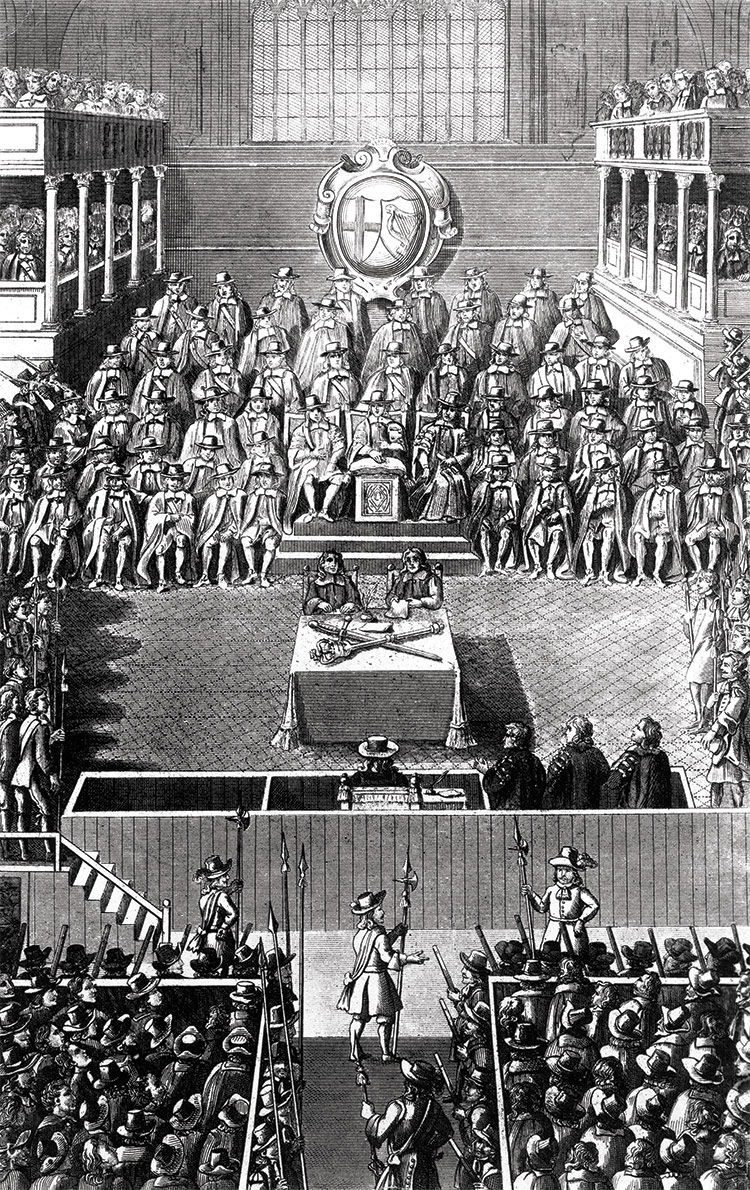 Above: Charles I's trial on 20 January 1649 in Westminster Hall.
Above: Charles I's trial on 20 January 1649 in Westminster Hall.
The king's tribulations were compared to Christ's suffering at the hands of the Pharisees, which was indicative of the heated religious climate in which the king's trial took place. The trial had been carefully planned well in advance, with thought being given to the venue, the ceremony and the need to preserve a measure of dignity. As Kelsey notes, 'one might say that the trial of Charles I was merely the pretext for a spectacular exercise in managing political appearances. It demonstrated that the civilians had once again taken command of the wheel-house of state'. But the trial did not go as planned. Members of the public shouted hostile comments during the proceedings, while the trial was delayed because of doubt as to whether the king should be seated and whether he should bear his head before the gathered assembly of judges. Marchamont Needham wrote scathingly of John Bradshaw's 'pride, impudence and superciliousness'; he was a 'vulgar spirit'.
Despite protesting vigorously that the trial was illegal, for 'no earthly power can justly call me (who am your King) in question as a delinquent... this day's proceeding cannot be warranted by God's laws', the king was condemned to death on 27 January. The judgement declared the king's guilt, having 'out of a wicked design to erect and uphold in himself an unlimited and tyrannical power to rule according to his will, and to overthrow the rights and liberties of the people, and to take away and make void the foundations thereof'. Charles was named as 'the occasioner, author, and continuer of the said unnatural, cruel, and bloody wars, and therein guilty of high treason, and of the murders, rapines, burnings, spoils, desolation, damage, and mischief to this nation acted and committed in the said war, and occasioned thereby'.
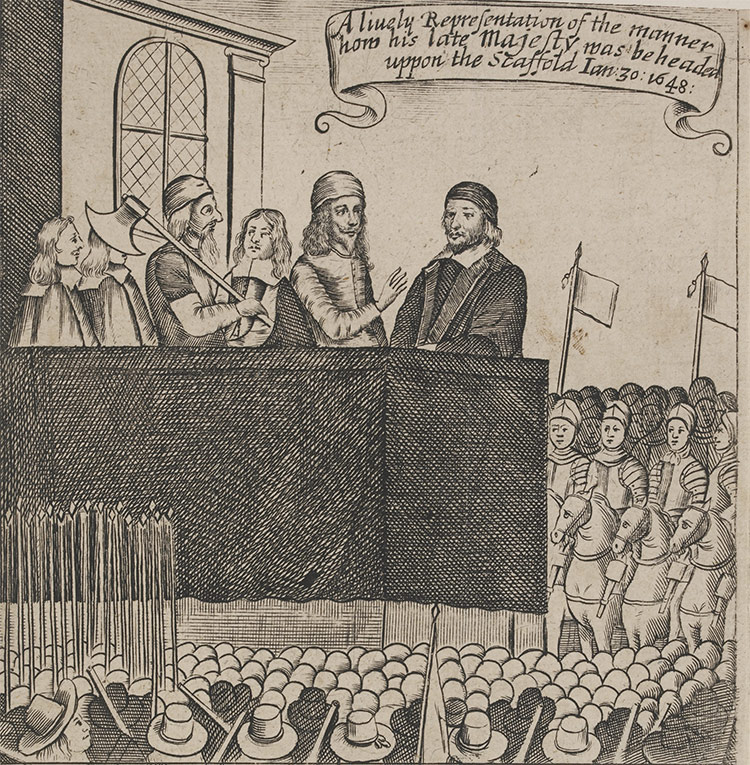 Above: The execution of Charles I.
Above: The execution of Charles I.
The disgraced king spent his final days writing letters to those he loved, including James, duke of York, and Henry, duke of Gloucester, begging them not to allow themselves to be used by their enemies to seize the throne from its rightful heir, their brother Charles. The king also wrote a last political will and testament to his son Charles, prince of Wales, beseeching him to stand by the Church and to provide justice.
On 30 January, a bitterly cold day, the fallen king was brought to a scaffold erected in front of the Banqueting House at Whitehall. Wearing two shirts, the king displayed self-control and dignity. In his speech to the crowd, he described himself as 'the martyr of the people', who had died to preserve the liberties of his people by upholding a God-given form of government. He remarked: 'I shall go from a corruptible to an incorruptible Crown, where no disturbance can be'. The poet Andrew Marvell, in 'An Horatian Ode Upon Cromwell's Return to Ireland', described Charles thus: 'He nothing common did or mean upon that memorable scene... Nor called the gods with vulgar spite to vindicate his helpless right, But bowed his comely head down as upon a bed'. Kneeling before the block, Charles gave the signal to the executioner and he was decapitated with a single stroke. His head was later sewn back onto his body. Charles was buried at Windsor on 9 February. Several days later, the Eikon Basilike, a memoir purporting to have been written by the king, began to circulate. The book contained the king's alleged final thoughts and self-assessment, and was one of the biggest sellers of the century: 40 English language impressions and issues were published in 1649 alone, while twenty more appeared in Dutch, German, French, and Danish. Five more English impressions were issued in the following decade, and 24 more from the Restoration to the eighteenth-century.
Charles remains a controversial figure. He has suffered at the hands of historians: Barry Coward condemned him as 'the most incompetent monarch of England since Henry VI', while Ronald Hutton opined that Charles was 'the worst king we have had since the Middle Ages'. Whatever Charles was, there can be no doubt that his brutal end on a frosty day in January 1649 had severe political and religious repercussions that unsettled England evermore.
 The religious policies of England's first queen regnant, Mary I (1553-58), undoubtedly defined her reign, both within her lifetime and within the historiography subsequently produced about her. Mary's infamous sobriquet, "Bloody Mary", derives from her alleged bloodthirsty persecution of 300 godly Protestants. In popular culture, the queen is often depicted as a vengeful, tyrannical and cruel woman who mercilessly ordered the deaths of hundreds of her subjects for their religious beliefs. Mary's Catholic religion was central to her sense of identity. It was recorded that she 'felt so strongly on this matter of religion that she was hardly to be moved'. Yet recent historians have, quite rightly, questioned the traditional interpretation of Mary's decision to return England to Roman Catholicism as foolish, naive and contrary to her subjects' wishes. Historians, including Eamon Duffy, have put forward compelling evidence for much of the general population's continuing loyalty to the Catholic religion and their hostility towards the Protestant reforms introduced in the reign of Edward VI. In certain geographical areas, including much of the north and southwest, Catholicism continued to be embraced wholeheartedly. The succession of a Catholic queen was viewed eagerly and delightedly, and Mary's religion indisputably contributed to the overwhelming support she received when fighting against the regime of Lady Jane Grey in the summer of 1553, a struggle that she was successful in. Susan Brigden has rightly said that, upon her accession, 'there was... popular rejoicing at the restoration of the old faith', as relics, altars and the Mass were restored to churches across the country. It is significant that the Mass, in particular, was sung across England not by royal command but 'of the people's devotion'.
The religious policies of England's first queen regnant, Mary I (1553-58), undoubtedly defined her reign, both within her lifetime and within the historiography subsequently produced about her. Mary's infamous sobriquet, "Bloody Mary", derives from her alleged bloodthirsty persecution of 300 godly Protestants. In popular culture, the queen is often depicted as a vengeful, tyrannical and cruel woman who mercilessly ordered the deaths of hundreds of her subjects for their religious beliefs. Mary's Catholic religion was central to her sense of identity. It was recorded that she 'felt so strongly on this matter of religion that she was hardly to be moved'. Yet recent historians have, quite rightly, questioned the traditional interpretation of Mary's decision to return England to Roman Catholicism as foolish, naive and contrary to her subjects' wishes. Historians, including Eamon Duffy, have put forward compelling evidence for much of the general population's continuing loyalty to the Catholic religion and their hostility towards the Protestant reforms introduced in the reign of Edward VI. In certain geographical areas, including much of the north and southwest, Catholicism continued to be embraced wholeheartedly. The succession of a Catholic queen was viewed eagerly and delightedly, and Mary's religion indisputably contributed to the overwhelming support she received when fighting against the regime of Lady Jane Grey in the summer of 1553, a struggle that she was successful in. Susan Brigden has rightly said that, upon her accession, 'there was... popular rejoicing at the restoration of the old faith', as relics, altars and the Mass were restored to churches across the country. It is significant that the Mass, in particular, was sung across England not by royal command but 'of the people's devotion'.
Contrary to the popular legend of Queen Mary as a bloodthirsty and tyrannical monarch who forced the unpopular Catholic religion upon her unwilling subjects, she initially demonstrated, in the words of Ann Weikel, 'flexibility and political sensitivity'. The Catholic religion was not immediately reintroduced until several months into the queen's reign. Mary may have been unsure of her subjects' attitudes and clearly desired to proceed carefully and hesitantly in so delicate and controversial a matter. On 18 August 1553, the queen issued a proclamation promising that she would not coerce any of her subjects into practising Catholicism until parliament was called, an announcement which mirrored Queen Elizabeth I's promise not to 'open windows into men's souls'. Mary faced a dilemma, however. The situation in England, both religious and political, was not the same as it had been in her youth, over twenty years earlier, when Roman Catholicism was still the state's religion as it had been for hundreds of years. The dissolution of the monasteries in the reign of her father, Henry VIII, had profited the upper and middle orders, who understandably were reluctant to renounce the wealth they had acquired from dissolved abbeys and religious houses. The queen was cautioned by Bishop Gardiner that enforcing the restoration of church lands would fatally undermine the Catholic cause, and wisely she chose not to follow that path. In October, the reforms of Edward's reign were repealed during the first session of Mary's parliament. The queen legislated that her parents' marriage had been good and lawful, and rejected the Supremacy of the Church. On 30 November 1554, England was absolved by Cardinal Pole, and two months later, the Royal Supremacy was formally repealed. Leading Protestant churchmen, including Archbishop Thomas Cranmer, John Bradford, John Rogers, John Hooper and Hugh Latimer were imprisoned. Mary disliked Cranmer, in particular, for she held him responsible for the annulment of her parents' marriage.
Mary had made an unpopular religion with Philip of Spain in July 1554, a marriage that provoked Wyatt's Rebellion in early 1554 and was linked by her resentful Protestant subjects with 'popish' tyranny and foreign domination. They had reason to worry, for in November the medieval heresy laws were revived, in which burning at the stake was issued as punishment for heretical practices and beliefs. Traditionally, historians have asserted that the queen faced an impossibly difficult uphill battle in her desire to restore Catholicism that she was never going to succeed in. As Brigden explains, 'the old world of religious unity and obedience was broken'. Ambivalence existed among the general population to the idea of papal supremacy, while traditional Catholic practices such as prayers for the dead, belief in purgatory, processions, creeping to the cross on Good Friday, palms on Palm Sunday, and the 'burial' of the Host in the Easter sepulchre proved exceptionally difficult to reintroduce across the country. However, while the Marian regime faced difficulties, it is inaccurate to view their religious policies as backward and stagnant. Altars, windows and vestments were reintroduced into parish churches alongside resplendent roods, but Cardinal Pole, who arrived in England in late 1554, was a renowned reformer who 'had deeper designs for Catholic reform than the recovery of what was past' (Brigden), and restored old practices as means of moving forward with new reforms. The Marian regime had a focus on scripture, teaching and education that had been lacking in traditional Roman Catholic systems. Thus, papal supremacy and priestly power were marginalised in the reforms of the Marian Church, while the cult of the Blessed Virgin, saints and pilgrimages played far less of a role in popular devotion than they had done previously. Catholic reformers hoped to fully restore England to the old religion by reconciliation and education, pursuing an initially peaceful and positive path that hoped to renew the traditional religion of Catholicism. The cardinal 'had considerable experience and talent to bring to the revitalization of the faith', given his excellent reputation as a humanist and his role as advocate for reform at the early sessions of the Council of Trent (Weikel). He assured Parliament in late 1554 that he had arrived in England 'to reconcyle, not to condemne... not to destroy but to build... not to compel but to call agayne'.
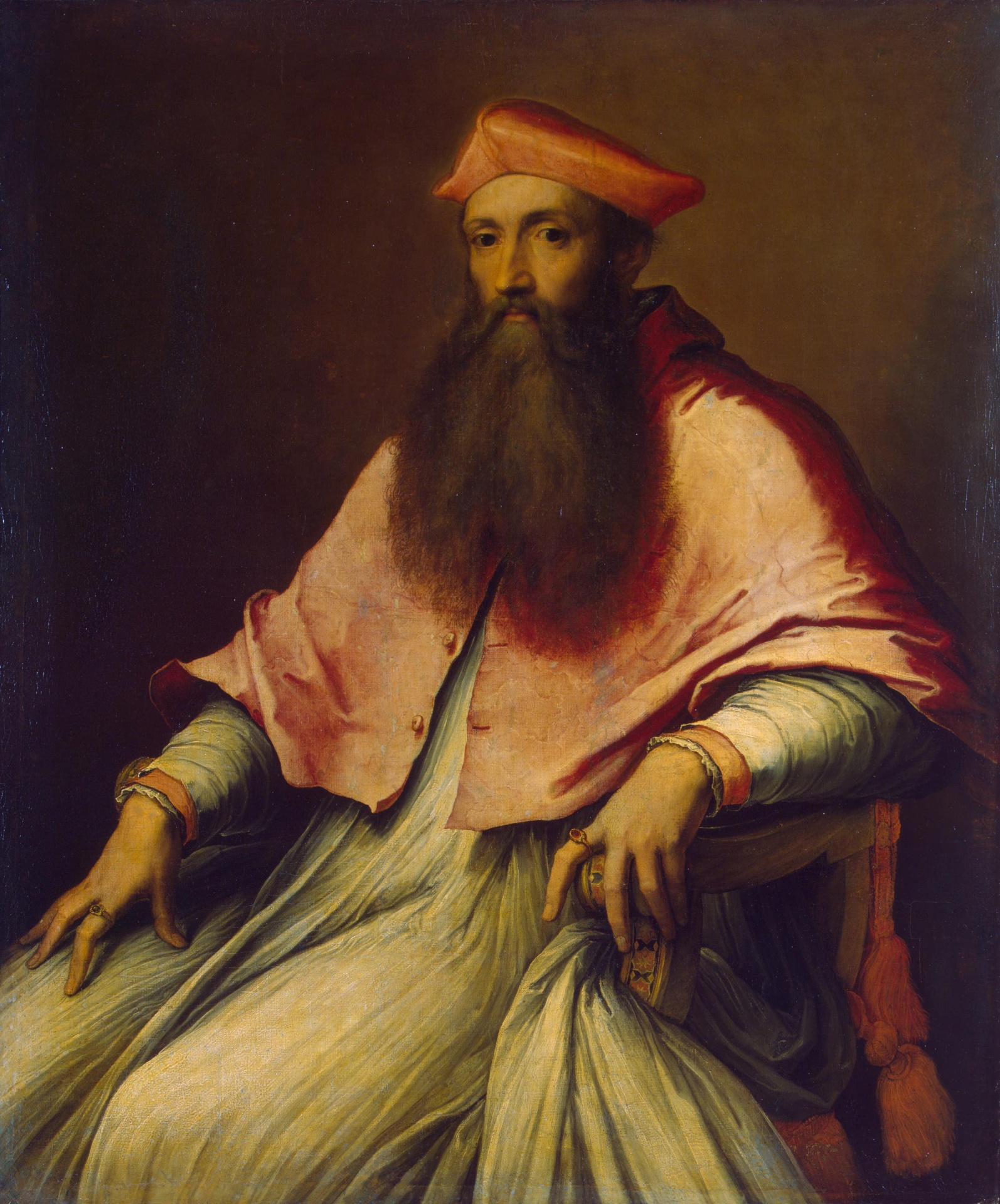 Above: Cardinal Reginald Pole.
Above: Cardinal Reginald Pole.
Pole placed particular emphasis upon episcopal and clerical leadership and training, concentrating on the education of the clergy and, through them, the laity. These bishops produced strong defences of the Catholic faith. The Marian regime hoped to take advantage of the expanded printing press, as the Protestant regime of Edward's reign had done so so efficiently and effectively. Thomas Watson, bishop of Lincoln, and Edmund Bonner were two notable clerics who authored defences of Catholicism. In his efforts, Pole was assisted by the Pope, who later recalled him on charges of heresy. The Marian programme of Catholic restoration, however, inevitably included the pursuit of heresy; a pursuit validated and made possible by the return of the heresy laws late in 1554. It is an exaggeration to claim that most of England's Protestant subjects were brutally and cold-bloodedly sent to the stake by their hateful, murderous queen. Notable clerics were sent to the stake, including Bishops Hooper, Latimer and Ridley late in 1555 and Archbishop Cranmer in the spring of 1556. The burnings were motivated by the conviction of the queen and Pole that heresy needed to be exterminated from society in order to prevent its spread, for it was a disease that had the power to 'infect'. The Marian regime hoped to reconcile dissenting subjects and bring them back to the Catholic fold, meaning that, in the long-term, each burning was an act of failure for the regime. The martyrs were widely supported at the burnings, meaning that the executions came to be held in secret, with the hope of avoiding large crowds. They gradually became less and less popular. After June 1558, the burnings at Smithfield were halted. Mary's decision to restore the medieval heresy laws and, with them, the death by burning for heresy, has been viewed by historians as crucial evidence of her 'backward' and 'ignorant' thinking, her inability to adapt to current situations and circumstances, but it is impossible to identify who was truly responsible for the burnings, as Weikel notes: 'there is little explicit evidence for her [Mary's] continuing involvement, except for the obvious fact that as queen she could have halted the process at any moment'.

 Above: Thomas Cranmer (left) and Hugh Latimer (right) were both burned at the stake in Mary's reign.
Above: Thomas Cranmer (left) and Hugh Latimer (right) were both burned at the stake in Mary's reign.
It is important to recognise that the negative depiction of Mary I's religious policies ultimately lies in the success of Protestant propaganda and its impact on the creation of national history. As Weikel explains, this propaganda has obscured the many positive aspects of the queen's religious regime. It is virtually impossible to know with any certainty how popular her restoration of Catholicism was, for we lack the attitudes of ordinary people across the country. Historians have uncovered evidence of a desire to return to the old religion, and celebrations across England at news of Mary's accession speaks volumes about her initial popularity among her subjects. In the end, circumstances beyond the queen's control defeated her efforts at Catholic restoration: 'Mary's regime was fatally undermined, not so much by failings in policy, but by disasters beyond human control' (Brigden). Pole was recalled by a vengeful pope, which demoralised both him and the queen, while a 'devastating mortality crisis' in 1558-9 was significant in that the queen was one of its victims. Mary died in November 1558, aged only 42, with no Catholic heir and having been queen for only five years: the shortest reigning of the five Tudor monarchs. Had she given birth to a Catholic heir, had she reigned for longer, it is quite conceivable that England's return to Roman Catholicism might have been, in the long-term, successful. The Marian regime was not 'backward' or 'stagnant' in its religious reforms and policies. It was energetic, vivacious, resourceful and purposeful in seeking to restore the old religion. As eighteenth-century historian John Lingard explained, Mary's policies failed, not because they were unpopular or 'wrong', but because her reign was too short to fully establish them, while natural disasters beyond her control ultimately undid her efforts. Elizabethan propaganda skilfully 'stamped Catholicism as an alien presence in England, and has consequently prevented 'a just assessment of the aims and achievements of the Marian Church'' (Weikel and Duffy). We, however, do not have to uncritically read such propaganda in our own times. We can afford England's first queen regnant respect and admiration for her concerted attempts to restore Roman Catholicism to a country which, in many respects, cried out for its return upon her accession.
 There appears to be a tendency of late to describe Henry VIII's second and most famous wife, Queen Anne Boleyn, as a 'modern woman'. It began with Eric Ives in his 2004 masterpiece The Life and Death of Anne Boleyn, in which he referred to Anne as 'a self-made woman' who broke the mould, independently carving out her own destiny at a time when women were politically, socially and culturally oppressed. Cultural depictions of Anne soon followed suit. In The Other Boleyn Girl, a ruthlessly ambitious Anne plots to marry Henry Percy, future duke of Northumberland, as a means of acquiring wealth, position and power - to her family's horror and disgust. They remind her that it is the job of her male relatives to find her a husband, rather than it being her prerogative. In the television series The Tudors, Natalie Dormer portrayed Anne as, in the words of academic Susan Bordo, 'a woman too smart, sexy, and strong for her own time', who was 'unfairly vilified' for her defiance of sixteenth-century norms. Recently, respected historian John Guy referred to Anne in an interview with BBC History Magazine as 'a modern woman'. Finally, actress Claire Foy (who plays Anne in the BBC television series Wolf Hall), described Anne as 'really a modern woman who believed that she could rise above where she was born'. The consensus seems to be that Anne Boleyn, in her fierce independence, assertiveness, confidence in her relations with men, and determination to carve out her own destiny, was a woman who should have lived in the twenty-first century, rather than in the sixteenth.
There appears to be a tendency of late to describe Henry VIII's second and most famous wife, Queen Anne Boleyn, as a 'modern woman'. It began with Eric Ives in his 2004 masterpiece The Life and Death of Anne Boleyn, in which he referred to Anne as 'a self-made woman' who broke the mould, independently carving out her own destiny at a time when women were politically, socially and culturally oppressed. Cultural depictions of Anne soon followed suit. In The Other Boleyn Girl, a ruthlessly ambitious Anne plots to marry Henry Percy, future duke of Northumberland, as a means of acquiring wealth, position and power - to her family's horror and disgust. They remind her that it is the job of her male relatives to find her a husband, rather than it being her prerogative. In the television series The Tudors, Natalie Dormer portrayed Anne as, in the words of academic Susan Bordo, 'a woman too smart, sexy, and strong for her own time', who was 'unfairly vilified' for her defiance of sixteenth-century norms. Recently, respected historian John Guy referred to Anne in an interview with BBC History Magazine as 'a modern woman'. Finally, actress Claire Foy (who plays Anne in the BBC television series Wolf Hall), described Anne as 'really a modern woman who believed that she could rise above where she was born'. The consensus seems to be that Anne Boleyn, in her fierce independence, assertiveness, confidence in her relations with men, and determination to carve out her own destiny, was a woman who should have lived in the twenty-first century, rather than in the sixteenth.
I'm not afraid to intrude here with my own opinion and say that I find this a deeply unsettling and, in many ways, disturbing interpretation of Anne Boleyn. I feel it relies heavily on the prejudiced dispatches of the Spanish ambassador Eustace Chapuys and on the traditional belief that it was Anne who called the shots in her dealings with men, namely Henry VIII. Several historians have argued, and cultural depictions of Anne in film and television have followed suit in this, that Anne manipulated Henry, even pressured him into making her his queen, and cajoled him into treating his first wife and eldest daughter with studied cruelty. In short, the lingering view of Anne as a home-wrecker remains prevalent because of its attractiveness to a twenty-first century worldview. Nowadays, of course, such a woman would be termed a home-wrecker, a whore, a schemer or a manipulator (or, of course, all of these things and more).
 Above: Natalie Dormer played a 'modern' Anne Boleyn in The Tudors.
Above: Natalie Dormer played a 'modern' Anne Boleyn in The Tudors.
What is the evidence for the claim that Anne Boleyn was 'a modern woman'? Surprisingly, proponents of the 'modern' view have not always specified what it supposedly was about Anne that makes her seem closer to the twenty-first century in her behaviour and character than to her own age. Bordo suggested that it was Anne's inability to shut up, her assertiveness, her independence, at a time when women were expected to be submissive, self-effacing and, above all, silent. The depiction of Anne as confident in her speech, taking on and arguing fiercely with a host of men including her uncle, father and husband, relies on the evidence of Chapuys' dispatches and hostile accounts produced by the likes of George Cavendish. Chapuys asserted that Anne fell out with her uncle, the duke of Norfolk, namely because he took offence at her outspoken and, at times, vitriolic speech. He also claimed that Anne, a crafty and cunning seductress, was responsible for pressuring Henry into mistreating his first wife, Katherine of Aragon, and his daughter by her, Mary. Were it not for the 'wicked' Anne, Chapuys believed, Henry might be persuaded to return to his 'true' wife. Indeed, Anne was so powerful at court and dominated her husband so completely, the ambassador proclaimed, that 'there is no one who dares contradict her, not even the king himself'. Chapuys also asserted, somewhat incredibly, that Anne controlled and ruled the government of the realm completely.
Several historians have questioned Chapuys' hostile reports, with some justice. They have convincingly demonstrated that his evidence was often false. His dispatches were written with a clear agenda: to blacken the name of Anne and, he hoped, bring about the reconciliation of Henry and Katherine. Chapuys did not blame the king for his decisions, including his increasingly harsh treatment of his daughter. Instead, the ambassador resorted to employing the centuries-old trope of the wicked stepmother, casting Anne as a nagging and assertive shrew who hen-pecked her long-suffering husband into doing her will.
There is plentiful evidence outside of Chapuys' reports that Anne upbraided the king for his extramarital affairs. Numerous stories, some of them lurid, tell of the queen's despair and shock at finding her husband with his future wife, Jane Seymour, on his lap in January 1536, thus bringing about a miscarriage. Anne found it difficult to reconcile the decade-long passion Henry had for her with the disturbing knowledge that he expected her to tolerate his infidelities once they were married. Numerous observers reported of the 'coldness and grumbling' between the couple during their marriage. The queen certainly was hurt, offended and devastated by her husband's affairs with other women, and at her trial in May 1536, she openly admitted: 'I do not say that I have always borne towards the King the humility which I owed him, considering his kindness and the great honour he showed me and the great respect he always paid me; I admit too, that often I have taken it into my head to be jealous of him... But may God be my witness if I have done him any other wrong'. Anne freely declared that she had suffered pangs of jealousy over her husband's extramarital amours.
But does this render Anne 'modern'? To our knowledge, Henry VIII's subsequent wives did not upbraid him for his infidelities (if they knew about them). But Henry's first queen, Katherine of Aragon, seems to have reacted with hostility when news was brought to her of her husband's liaison with his first-recorded mistress, Lady Anne Stafford, in the early 1510s, and court observers commented that the couple were noticeably 'vexed' with one another for some time. There is little evidence of the conservations between other kings and queens at this period, so it is difficult to attempt to compare the personal relationship of Henry and Anne with another royal couple in similar circumstances; furthermore, we lack detailed evidence for how the ordinary populace viewed the extramarital affairs of their paramours, outside of legal documents produced in the Church courts. To us, Anne's despair and sadness at her husband's affairs are understandable, for we value companionate marriage in the twenty-first century Western world. There is an expectation that partners will be faithful to one another, and will have married for love. But it surely seems a step too far to describe Henry's second wife as 'modern' because she experienced upset and hurt over his sexual affairs. Plenty of women in the sixteenth-century might have experienced similar emotions - we lack evidence for them. Anne Boleyn, by virtue of her status as queen, was in an exceptional position for evidence of her feelings to be recorded. Just because we lack evidence for the emotions of others when news was brought to them of their partners' infidelities does not mean that she was 'modern' and others were not.
 The view of Anne as 'a modern woman' ignores a wealth of evidence which proves that she was a product of her time and culture. The evidence of John Foxe and William Latimer indicates that she was a religious and charitable queen with an earnest and pious faith. She was interested in evangelical reform and patronised religious radicals. Anne followed her predecessor in giving alms to the poor and engaging in charitable pursuits that were, unfortunately for her, not publicised in her own lifetime. Anne did not have 'modern' views about social status, later known as 'class': when her sister dared to marry beneath her, the queen reacted with anger and shock, immediately banishing her from court. She also demonstrated humility in relation to her ascendancy to the queenship, informing contemporaries that the king had been 'inspired' by God to marry her, perhaps perceiving it as God's will.
The view of Anne as 'a modern woman' ignores a wealth of evidence which proves that she was a product of her time and culture. The evidence of John Foxe and William Latimer indicates that she was a religious and charitable queen with an earnest and pious faith. She was interested in evangelical reform and patronised religious radicals. Anne followed her predecessor in giving alms to the poor and engaging in charitable pursuits that were, unfortunately for her, not publicised in her own lifetime. Anne did not have 'modern' views about social status, later known as 'class': when her sister dared to marry beneath her, the queen reacted with anger and shock, immediately banishing her from court. She also demonstrated humility in relation to her ascendancy to the queenship, informing contemporaries that the king had been 'inspired' by God to marry her, perhaps perceiving it as God's will.
Furthermore, it has been pointed out by the likes of Warnicke that Henry VIII may have exercised considerably more control over his relationship with Anne than is traditionally believed. We lack her replies to his letters and so do not know how she was responding to him. The prevailing view, that she treated him calculatingly and ruthlessly, with an eye to the throne and a future as queen, rests on no convincing evidence for the simple reason that there really is no evidence. Anne was surely no more ambitious than Jane Seymour, Katherine Howard or Katherine Parr, and it is a step much too far to suggest that she actively set out to destroy the king's first marriage and seduce him into marrying her in a move that resembles that of the modern 'home-wrecker'. Amy Licence has credibly argued, following in the lead of writers such as Karen Lindsey and Joanna Denny, that Anne may have been unwilling or afraid to reply to the king. Perhaps she did not want to become queen. Perhaps, in short, the king pressured her into accepting his advances, a possibility that is often not given the attention it deserves.
Chapuys' dispatches have recently been termed little more than fiction by historians who are convinced that nothing he reported about Anne can be trusted as the truth. This may be a step too far: perhaps there was some truth in his claims that she was fiercely outspoken and assertive, not afraid to upbraid the king for faults she perceived in him. But is this really evidence that she was 'modern'? Henry's final wife, Katherine Parr, challenged his religious beliefs and dared to lecture him when she believed he was in error. Yet Katherine does not tend to be identified as a 'modern woman' somehow transported back in time to the sixteenth-century, although there is an unsettling line of thought which regards her as something of an early feminist. Anne Boleyn was, as Susan Bordo makes clear, no feminist, and neither was she a modern woman. She was a product of her time and the view of her as 'modern' ignores a significant amount of evidence produced by contemporaries. Much of the evidence for her 'modernity' is shaky: either produced by hostile onlookers or supposedly written by Anne herself. I refer here to the infamous letter from 'the Lady in the Tower' in May 1536, in which the queen upbraided her husband for seeking to kill her so that he could marry his new love. Most historians are convinced that Anne was not the real author of this letter, believing that it was penned sometime in the Elizabethan period, long after her death. If evidence for Anne as a 'modern woman' is mostly hostile, non-existent or doubtful, then it cannot, on a balance of probabilities, be claimed that she was ahead of her time in her beliefs, attitudes and behaviour. Anne was a product of her time and class: she may have been assertive, outspoken and ambitious, but other women were too and it certainly cannot be claimed that she was 'a self-made woman', when one examines her family networks and their role in providing her with an excellent education and marriage prospects.
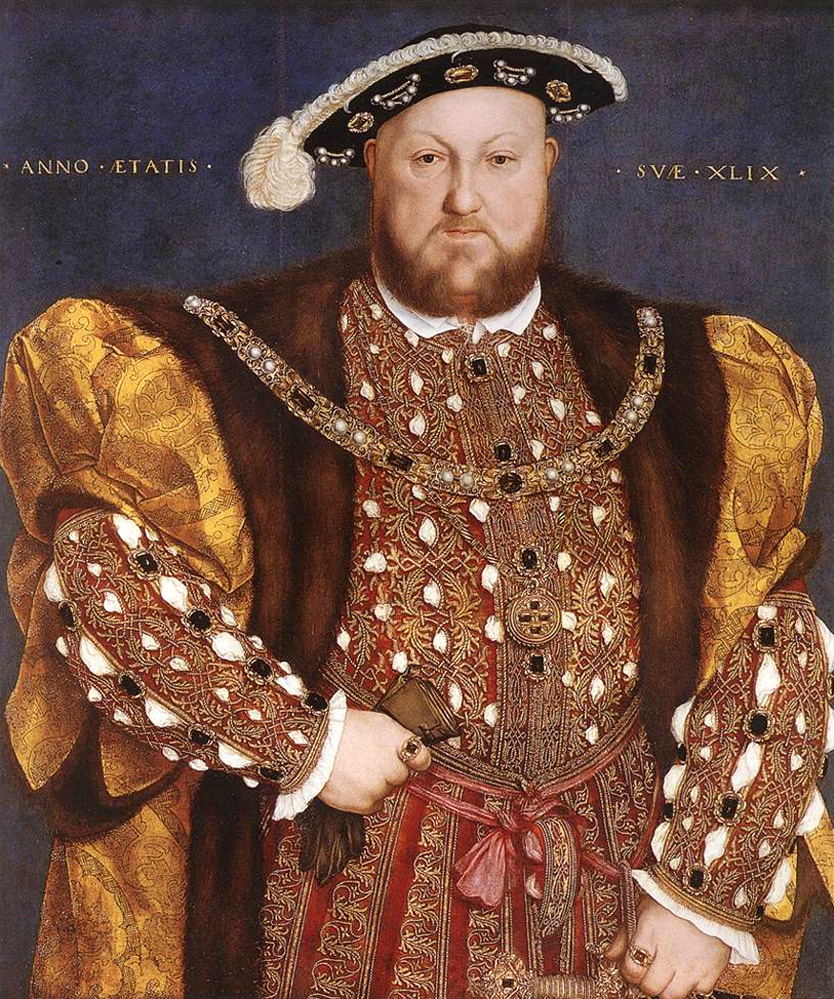
 Above: Henry VIII of England (left) and his wife, Anne of Cleves (right).
Above: Henry VIII of England (left) and his wife, Anne of Cleves (right).
On Tuesday 6 January 1540, King Henry VIII of England married for the fourth time, to Anne of Cleves, in the Queen's Closet at Greenwich Palace, the king's favourite residence. The king was dressed in a gown of cloth of gold that was embroidered with great flowers of silver and banded with black fur, a coat of crimson satin slashed and embroidered and fastened with diamonds, and a rich collar of gold about his neck.
Henry's twenty-four year old bride was attired in a gown of cloth of gold embroidered with large flowers of great Orient pearls, in the Dutch fashion, with a round skirt and no train. Her long fair hair hung loose to symbolise her virginity, and she wore a coronet of gold upon her head that was set with precious stones and trefoils that resembled bunches of rosemary. Anne also wore a costly necklace and matching belt around her waist.
Henry VIII's marriage to Anne of Cleves has traditionally been seen as the culmination of his minister Thomas Cromwell's drive to achieve an alliance with a Protestant power, in which Cromwell sought to steer England's religion in an increasingly radical path. At the time of the wedding negotiations, the Catholic superpowers France and Spain were united against England. However, some historians have called this into question, and have stressed the personal role played by Henry himself. Of his six wives, Anne of Cleves was second only to his first consort Katherine of Aragon in her lineage and breeding. She was excellently connected and marriage to her brought the promise of assured prestige for England. Marriage to Anne, as with marriage to Katherine of Aragon, established England's influence and standing on an international level in a manner that did not apply to the king's marriages with English subjects.
Famously, Henry disliked his fourth wife on sight, when they met at Rochester in December 1539. Following early modern protocol, in which monarchs traditionally greeted foreign-born consorts in disguise, Henry dressed in disguise and rode to meet Anne. The story goes that, unaware of the king's love of disguises and drama, Anne failed to see that this aged man in strange clothing was, in fact, her proposed husband. She afforded him a cold reception when he attempted to embrace her. Taken aback, the king later removed his costume and appeared before Anne, welcoming her to England, and she sank to her knees 'with most gracious and loving countenance and behaviour'. But the damage had been done. Henry appears to have been revolted, disgusted and - worst of all - profoundly humiliated. The king famously declared: "I see nothing in this woman as men report of her, and I marvel that wise men would make such report as they have done!" He knew, however, that he had to marry Anne both to save face and to avoid angering and humiliating the Duke of Cleves, and duly wed her on 6 January. He pointedly told his lords: "My lords, if it were not to satisfy the world and my realm, I would not do what I must do this day for any earthly thing".
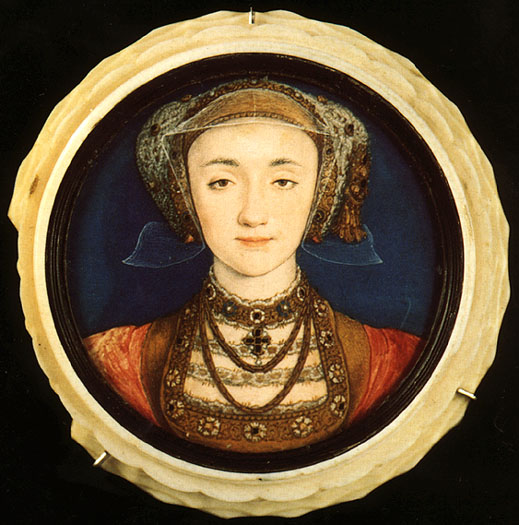 Above: Anne was reportedly popular among her English subjects.
Above: Anne was reportedly popular among her English subjects.
Whether Anne was aware of her husband's displeasure is impossible to tell. Traditionally, she has been unfairly depicted as something of a country bumpkin, a bland, dull and dim German girl who lacked courtly graces, played no musical instruments and, perhaps most surprisingly, knew nothing of sex. She has also sometimes been credited as being a Lutheran whose religious views bordered on heresy, but it seems, in fact, that her religion was entirely traditional in its Catholic leanings. In fact, Anne's beauty and charm were reported by many observers. The chronicler Edward Hall commented on Anne's 'goodly...stature' and 'womanly...countenance' while, after meeting her, William Fitzwilliam, earl of Southampton, praised Anne's 'excellent beauty, such as I well perceive to be no less than was reported'. If anything, it appears to have been Anne's fashion sense and style of clothing that caused bemusement and concern. Lady Browne, who supervised the new queen's maids of honour, was dismayed with the clothes worn by Anne, while Charles Marillac, the French ambassador, rather spitefully claimed that Anne's dress made her look older than thirty.
Historians have puzzled over why it was that Henry VIII rejected Anne. They have tended to believe that it was her physical ugliness that was the problem, thus validating the notion of her being a 'Flanders mare' (although this infamous label actually only came into existence in the eighteenth-century and was never used by Henry VIII to describe his wife). Retha Warnicke convincingly suggested, however, that psychological factors were at play. Henry believed that his wife was precontracted to the duke of Lorraine, and the knowledge that his wife had been promised to another could have inhibited him from consummating the match. Henry loudly voiced his concern about Anne's 'loose breasts and other tokens', for which 'I can have none appetite'. Maidens were believed to be flat-chested and small-breasted. Anne's body, in Henry's eyes, signified that she was not a virgin.
Although the new queen was not liked by her husband, she appears to have been respected, liked and even loved by her subjects. The French ambassador was to report, following the annulment of her marriage in the summer of 1540, that the English people were saddened to hear that she would no longer be their queen, for they esteemed her as 'one of the most sweet, gracious and humane queens they have had, and they greatly desire her to continue their queen'. As it turned out, Anne actually enjoyed the best fate of all Henry's six wives, becoming his 'sister' and enjoying a wealthy settlement that entitled her to a life of luxury. All of this, however, was way off in the future. When Anne of Cleves married Henry VIII on 6 January 1540 and became Queen of England, she could not have known of her husband's distaste for her, resulting in the annulment of her marriage and the loss of her queenship only six months later.











